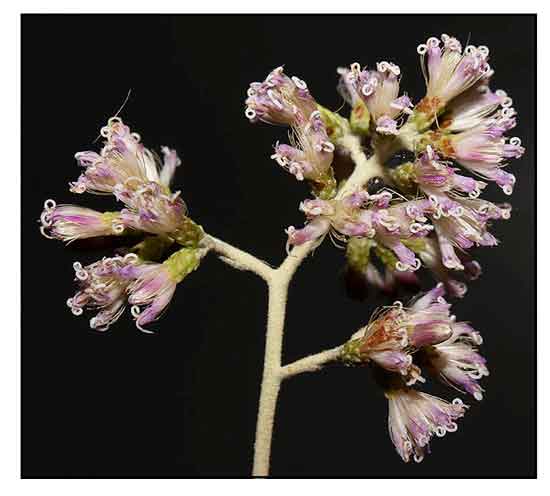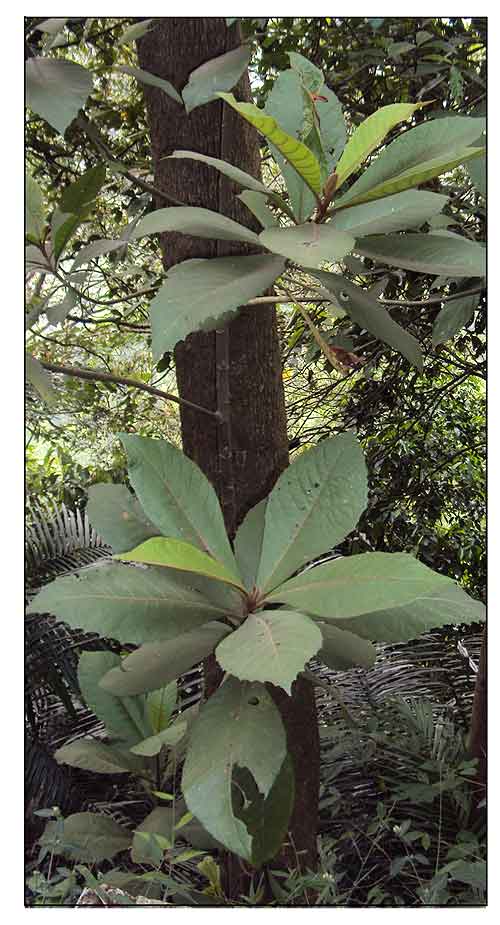 Gen info Gen info
- Strobocalyx is a genus of Asian, African, Pacific Island, and South American plants in the tribe Vernonieae within the family Asteraceae. It is sometimes regarded as part of the genus Vernonia. (2)
- Etymology: Strobocalyx derives from Greek words strobos meaning 'cone' and calyx meaning 'covering. The genus name Vernonia commemorates the English botanist, W. Vernon. The species epithet arborea derives from Latin, meaning tree, referring to its growth form.
 Botany Botany
• Trees or erect shrubs, to 20 m tall. Branches densely fulvous tomentulose or ± glabrescent, rarely glabrous. Petiole 10-30 mm, densely pubescent; leaf blade ovate, elliptic-ovate, or oblong, 8-25 × 4-10 cm, thinly leathery, abaxially white pubescent, densely so on veins, or glabrous, adaxially fulvous pubescent along veins or glabrous, glandular, lateral veins 8-12-paired, adaxially distinctly raised, veinlets reticulate, base obtusely rounded or attenuate, margin entire, apex acuminate. Synflorescences terminal, panicles broader than long, shallowly rounded to ± flat-topped. Capitula very many; peduncles to 10 mm, mostly much shorter, densely pubescent; bracteoles absent. Involucre cup-shaped, 2-3 × 6-8 mm; phyllaries ca. 5-seriate, ovate or ovate-oblong, 0.5-2 mm, densely pilose, rarely subglabrous, apex obtuse or subacute, outer very short, ovate. Receptacle flat, areolate. Florets 5 or 6; corolla pink, pale purplish, or white, tubular, 5-7 mm, lobes acute, glabrous. Style branches long. Achenes compressed, 2-3 mm, 3- or 4-angled and 8-10-ribbed, inconspicuously pilose and glandular. Pappus 1- or 2-seriate, dirty white; outer setae few, almost absent, ca. 1 mm; inner setae 5-7 mm. (Flora of China)
 • Trees, 5 - 20 m tall. Stems arborescent, terete, inconspicuously ribbed, branches ferruginuous pubescent. Leaves 8 - 20 by 4 - 10 cm, elliptic to oblong, margin entire, apex acuminate or caudate, base cuneate or oblique, coriaceous; both surfaces puberulous with filiform hairs and capitate glands; lateral veins 10 - 15 - paired; petioles up to 3 cm long. Capitulescences terminal or axillary, thyrsoid paniculate. Capitula narrowly campanulate, shortly pedunculate. Receptacle flat, glabrous. Involucres narrowly campanulate or slightly oblong-cylindrical, in 3 - 4 series, 2 - 3 mm long. Phyllaries imbricate, green or purple, margin piliferous, outer surface puberulous without glands; the outer ovate, apex obtuse or rounded; the inner ones ovate-lanceolate or oblong, apex obtuse. Florets 3 - 6; corollas funnelform, purple to white, glandular; corolla tubes 6 - 7 mm long; corolla lobes ca. 2 mm long. Anthers ca. 2.5 mm long, apical appendage acute, base obtuse. Styles purple. Achenes turbinate, ca. 2 mm long, 3 - 4 - angled and inconspicuously ribbed, pubescent with twin hairs and capitate glands. Pappus in 2 series of bristles, the inner ones 6 - 7 mm long. Pollen subechinolophate, 3 - colporate, with micropuncta. (GBIF) • Trees, 5 - 20 m tall. Stems arborescent, terete, inconspicuously ribbed, branches ferruginuous pubescent. Leaves 8 - 20 by 4 - 10 cm, elliptic to oblong, margin entire, apex acuminate or caudate, base cuneate or oblique, coriaceous; both surfaces puberulous with filiform hairs and capitate glands; lateral veins 10 - 15 - paired; petioles up to 3 cm long. Capitulescences terminal or axillary, thyrsoid paniculate. Capitula narrowly campanulate, shortly pedunculate. Receptacle flat, glabrous. Involucres narrowly campanulate or slightly oblong-cylindrical, in 3 - 4 series, 2 - 3 mm long. Phyllaries imbricate, green or purple, margin piliferous, outer surface puberulous without glands; the outer ovate, apex obtuse or rounded; the inner ones ovate-lanceolate or oblong, apex obtuse. Florets 3 - 6; corollas funnelform, purple to white, glandular; corolla tubes 6 - 7 mm long; corolla lobes ca. 2 mm long. Anthers ca. 2.5 mm long, apical appendage acute, base obtuse. Styles purple. Achenes turbinate, ca. 2 mm long, 3 - 4 - angled and inconspicuously ribbed, pubescent with twin hairs and capitate glands. Pappus in 2 series of bristles, the inner ones 6 - 7 mm long. Pollen subechinolophate, 3 - colporate, with micropuncta. (GBIF)
Distribution
- Native to the Philippines.
- In most islands and provinces from north Luzon to Mindanao. In low and medium elevation, up to c. 1000 m, mostly among forest edges and secondary forests. (7)
- Also native to Andaman Is., Assam, Bangladesh, Borneo, China South-Central, China Southeast, India, Jawa, Laos, Malaya, Myanmar, Nepal, New Guinea, Nicobar Is., Sri Lanka, Sumatera, Thailand, Vietnam. (1)
Constituents
- Study of leaves isolated sesquiterpene lactones containing α-methylene-γ-lactones, zaluzanin D (1) and zaluzanin C (2). Michael adducts (3-22) and Heck arylation analogs (23-34 of 1 were synthesized reacting with various amines and aryl iodides. (see study below) (6)
- Ethanol extract of leaves yielded alkaloid, flavonoid, saponin, tannin, and carbohydrate.
(see study below) (11)
Properties
- Studies have suggested antifungal, antibacterial, antioxidant, anti-inflammatory, wound healing properties.
Parts used
Bark, leaves, roots.
Uses
Edibility
- No reports or studies found on edibility.
Folkloric
- In the Philippines, an mix
-
In Indonesia, bark juice used for treatment of worms and chewed on first signs of sprue. Leaf juice also used for treatment of worms; bark decoction used for fever; leaf extract for treating septic wounds, jaundice fever, wound healing, and rheumatic pains. (5)
- In Borneo, mixture of leaves used for making a tonic for women after childbirth. (9)
- Roots used for treatment of fever. Bark used for treatment of aphthae.
Others
- Timber: Use as fuelwood. Used for light construction and making matches.
Studies
• Zaluzanin D / Antifungal / Aerial Parts: Study of aerial parts isolated Zaluzanin D, a sesquiterpene lactone, as major constituent (0.045). Antifungal activity of zaluzanin D was studies against six plant-pathogenic fungi. Antifungal activity was determined as inhibition of mycelial growth using poison food technique. Bavistatis, a commercial fungicide, was used as standard. Zaluzanin D showed 100% inhibition of mycelial growth of Rhizoctonia solani, about 75% with Curvularia lunata and Botrytis cinerea at 200 ppm concentration. (4)
• Anti-Inflammatory / Antioxidant / Leaves: Study evaluated the anti-inflammatory effect of ethanol leaf extract of V. arborea at concentrations of 100, 200, and 300 mg/kbw daily for 30 days against formalin induced inflammation in rats. Indomethacin (25 mg/kbw) was used as standard. Pretreatment with ethanol leaf extract significantly and dose-dependently (p<0.05)increased the levels of biochemical and hematolo-gical parameters, along with reduced antioxidant enzyme levels. The significant increase (p<0.05) in paw thickness and levels of serum enzymes, lipid peroxide, and leucocytes in rats treated with formalin were normalized with pretreatment with the leaf extract. Results demonstrated antioxidant and anti-inflammatory potential of ethanol leaf extract of V. arborea. (5)
• Anticancer / Sesquiterpene Lactones / Leaves: Study of leaves isolated sesquiterpene lactones containing α-methylene-γ-lactones, zaluzanin D (1) and zaluzanin C (2). Michael adducts (3-22) and Heck arylation analogs (23-34 of 1 were synthesized reacting with various amines and aryl iodides, and assayed for invitro anticancer activities against human breast cancer cell lines MCF7 and MDA-MB-231. Michael adducts 9 and 10 showed better anticancer activities compared to 1. Only compound 10 showed minimal cytotoxic effect on normal breast epithelial MCF10A cells. Compounds 9 and 10 exhibited antiproliferative activity via induction of apoptosis and inhibition of cancer cell proliferation. Results suggest compound 10 has potential as lead compound for designing of anticancer compound. (6)
• Antibacterial / Anti-Inflammatory: Study evaluated the wound healing activity of phytofractions of Vernonia arborea in an acute cutaneous impaired wound model using adult zebrafish to simulate mammalian wound pathophysiology. The model was used to evaluated for reduction of infection, myeloperoxidase (MPO) as marker of infection, neutrophil infiltration and resolution, kinetics of inflammatory cytokines, and wound repair kinetics. Results showed reduction of exvivo microbial bioburden up to 96% of infected wound tissue, reduction in CFU correlated with neutrophil kinetics and MPO enzymes, downregulation of expression of pro-inflammatory cytokines (IL-6 and TNFα) and NO signaling with fourfold increase in iNOS expression. Results suggest the zebrafish wound model has potential as a standard tool for assessing phytoextracts for wound healing with antimicrobial properties. (8)
• Antibacterial / Antioxidant / Leaves: Study evaluated the antioxidant and antibacterial potential of V. arborea leaf using DPPH radical scavenging assay and agar well diffusion method against Escherichia coli and Propionibacterium acnes. The n-hexane leaf extract yielded alkaloid and the coumarin in ethyl acetate extract. Antioxidant testing showed highest inhibition of 83% at 50 pp, concentration of ethanol solvent. Antibacterial activity showed highest inhibition zone of 12 mm and 11 mm at 400 µg for E. coli and P. acnes respectively. Results suggest potential as a natural traditional medicine (11)
• Wound Healing / Bark: Study evaluated the wound healing activity of Vernonia arborea using excision, incision, and dead space wound models on Wistar rats. A 5% w/w ointment formulation from aqueous and methanol bark extracts using 2% sodium alginate and 30 mg/ml suspensions in 1% gum tragacanth/kbw were used. Results showed aqueous and methanol extract significantly promoted wound healing activity in all wound models studies. Results showed high rate of wound contraction, decrease in period of epithelization, high skin breaking strength and granulation strength, increase in dry granulation tissue weight, elevated hydroxyproline content, and increased collagenation in histopathology exam of granulation tissue. The methanol extract possessed better wound healing property than the aqueous extract. (12)
Availability
Wild-crafted. |







